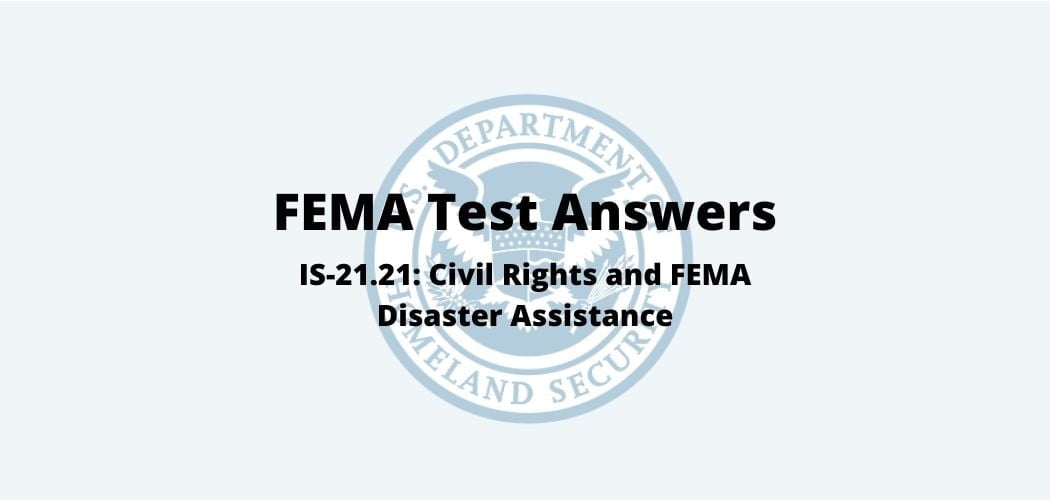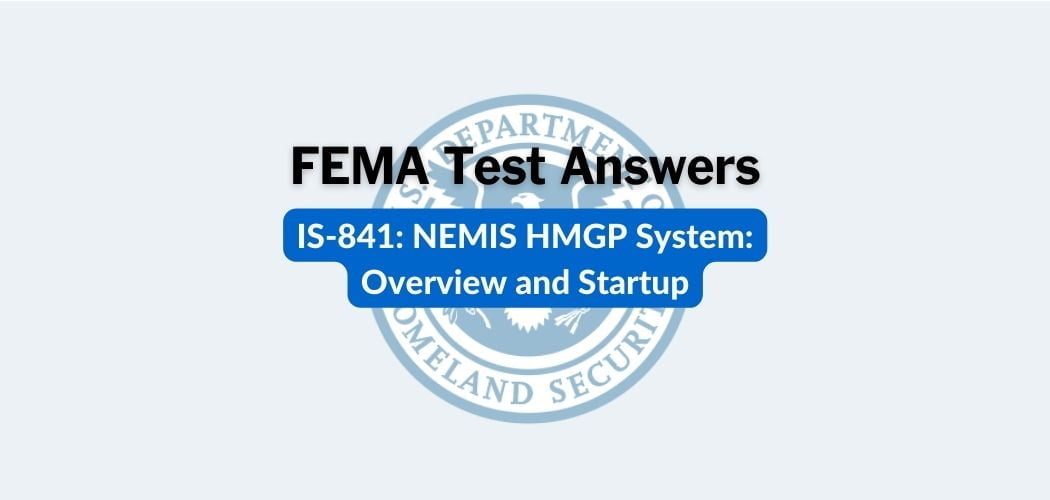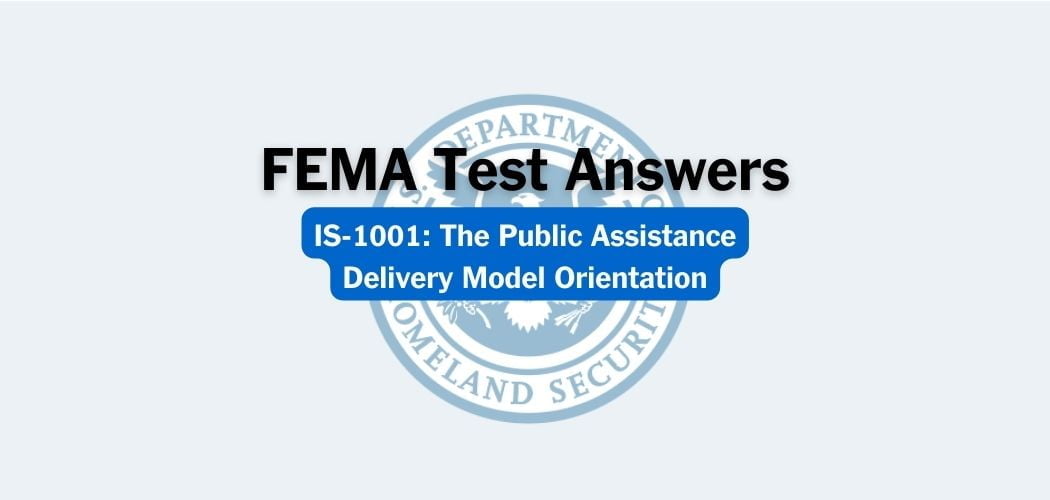Overview: The FEMA IS-1106.A course was published on 12/28/2016 to provide a practical look at how changes to FEMA flood maps affect property owners, insurance agents, lending institutions, and others.
Primary audience: FEMA IS-1106.A course is for Insurance Agents, Property Owners, Floodplain Managers, Planners, and other local officials who are assisting property owners with flood map changes or determinations. Recommended prerequisite is IS-1101 Basic Agent Tutorial.
FEMA IS-1106.A test answers
Each time this test is loaded, you will receive a unique set of questions and answers. The test questions are scrambled to protect the integrity of the exam.
Question 1. A Letter of Map Revision acts as an unofficial amendment to a flood map pending the outcome of further study.
A. TRUE✅
B. FALSE
Question 2. What are an insurance agent’s primary rating options when properties are mapped into a Special Flood Hazard Area?
A. The Grandfather Rating Rules and the Newly Mapped Procedure
B. The Preferred Risk Policy and the Specific Rating Guidelines✅
Question 3. Flood insurance rates and mandatory purchase of flood insurance become effective during the 6-month adoption period.
A. TRUE
B. FALSE✅
Question 4. Properties newly mapped into an SFHA on or after April 1, 2015 are eligible for the Newly Mapped procedure if coverage is effective within _______ of map revision.
A. 3 months
B. 6 months✅
C. 12 months
D. 24 months
Question 5. Following a map revision, the status of previous Letters of Map Change is documented on a:
A. Summary of Map Zones
B. Summary of Map Status✅
C. Summary of Map Actions
D. Summary of Map Changes
Question 6. There are two rating approaches to grandfathering in the NFIP. They are:
A. Provisional rating and Tentative rating
B. Specific rating and Specific guidelines rating✅
C. Built-in-compliance rating and Continuous coverage rating
D. Submit-for-rate
Question 7. A Non-Special Flood Hazard Area is an area in Zone B, C, or X.
A. TRUE✅
B. FALSE
Question 8. The Newly Mapped procedure became effective on:
A. October 1, 2014
B. January 1, 2015
C. June 1, 2014
D. April 1, 2015✅
Question 9. The Newly Mapped procedure:
A. Is for buildings newly mapped into Special Flood Hazard Areas✅
B. Provides a preferred risk premium for 2 years
C. Replaces grandfathered rating
D. Is for buildings newly mapped into B, C, and X zones
Question 10. The first step in the flood mapping process is:
A. Map adoption
B. Scoping or discovery meeting✅
C. Preliminary map release
D. Data/map development
Question 11. A property removed from a Special Flood Hazard Area:
A. Is not eligible for a Preferred Risk Policy
B. Is now considered to be in an unmapped zone
C. Has its flood risk reduced✅
D. No longer has a risk of flood
Question 12. FEMA’s Map Service Center:
A. Requires a credit card account to purchase products
B. Ships materials upon receipt of payment only
C. Provides products only to government entities;
D. Provides online mapping products free of charge✅
Question 13. A FIRMette is a:
A. Method to test mattresses
B. Small business
C. Mapping job aid✅
Question 14. DFIRM stands for:
A. Digital Flood Insurance Rate Map✅
B. Direct Flood Insurance Rate Map
C. Digital Flood Insurance Risk Map
D. Direct Flood Insurance Risk Map
Question 15. Which one of the following is NOT how a flood zone is described on an NFIP policy declaration page?
A. Current zone
B. Historic zone
C. Flood risk zone✅
D. Rated zone
Question 16. The term 100-year floodplain means:
A. Flooding is expected every 100 years.
B. There is a 1% chance of flooding in any year.✅
C. It floods once every 100 years.
D. The area has flooded within the past century.
Question 17. The grandfather rules may result in lower premiums after changes in map zones and compliance standards.
A. TRUE✅
B. FALSE
Question 18. The abbreviations for the three types of FEMA flood maps are FBHM, FIRM, and EFIRM.
A. TRUE
B. FALSE✅
Question 19. The three types of FEMA flood maps are:
A. Flood Hazard Boundary Maps, Flood Insurance Risk Maps, Electronic Flood Insurance Rate Maps
B. Flood Hazard Boundary Maps, Flood Insurance Rate Maps, Electronic Flood Insurance Rate Maps
C. Flood Hazard Boundary Maps, Flood Insurance Rate Maps, Digital Flood Insurance Rate Maps✅
D. Flood Boundary Hazard Maps, Flood Insurance Rate Maps, Digital Flood Boundary Maps
Question 20. The Community Status Book is used to:
A. Provide a listing of participating NFIP communities✅
B. Determine the flood zones for each building in a community
C. Explain a community’s Flood Insurance Study
D. Locate the Base Flood Elevations in a community
Question 21. What is the dividing line between Pre-FIRM and Post-FIRM?
A. The community’s Regular Program entry date
B. The date of a community’s initial Flood Insurance Rate Map
C. The date of a community’s current Flood Insurance Rate Map✅
D. The date of a community’s initial Flood Hazard Boundary Map
Question 22. Which one of the following procedures is time sensitive and requires lender and borrower to jointly approach FEMA?
A. Letter of Determination Review
B. Letter of Map Change✅
C. Letter of Map Revision
D. Letter of Map Amendment
Question 23. A Preferred Risk Policy is:
A. Intended for properties in desert areas only
B. A low-cost policy for buildings in B, C, X, AR and A99 zones✅
C. Available to properties with 4 or more flood losses
D. The NFIP’s most comprehensive coverage form
Question 24. Which of the following cannot be located through the FEMA Map Service Center?
A. Certified flood zone determinations✅
B. Current flood maps
C. Preliminary flood hazard data
D. Letters of Map Change
Question 25. The unshaded areas on a non-digital FIRM represent flood zone(s):
A. AE and VE
B. C and X
C. B and D✅
D. D only
Question 26. How long does it take to update a community’s flood map?
A. 3 months
B. 6 months
C. 1 year
D. More than a year✅
E. Maps are updated every 3 years
Question 27. Following the release of preliminary flood hazard data, there is a:
A. 60-day appeals period
B. 90-day appeals period✅
C. 6-month appeals period
D. One-year appeals period
Question 28. The following zones are Special Flood Hazard Areas:
A. A and Z
B. A and V✅
C. A, V, and Z
D. A and D
E. A, V, and D
Question 29. Flood Insurance Rate Maps:
A. May display Base Flood Elevations and depict flood zones✅
B. Capture flood loss data
C. Are always used when a community is in the Emergency Program phase
Question 30. A Letter of Map Amendment request is typically made by:
A. A lender and an insurance agent✅
B. A property owner
C. A FEMA Mapping Specialist
D. A local community official
Question 31. Pre-FIRM buildings are those constructed prior to a community adopting its initial Flood Insurance Rate Map.
A. TRUE✅
B. FALSE
![[FEMA Test Answers] IS-5.A: An Introduction to Hazardous Materials - Test Pinoy](https://testpinoy.com/wp-content/uploads/2021/11/fema-is-5a.jpg)


